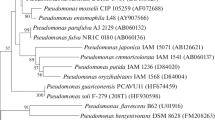Abstract
In this study, the kinetics of degradation of caffeine and related methylxanthines by induced cells of Pseudomonas sp. was performed. The kinetics data showed that degradation of caffeine, theobromine, and 7-methylxanthine followed Michealis–Menten kinetics. The values of K m are low for caffeine and 7-methylxanthine and high for theobromine. Degradation of caffeine and theobromine was enhanced in the presence of NADH and NADPH, whereas the degradation of 7-methylxanthine was unaffected. Among the various metal ions tested, Fe2+ was found to enhance the rate of degradation for all three substrates, whereas Zn2+ and Cu2+ inhibited the degradation of caffeine and theobromine but not 7-methylxanthine. The differences in kinetic parameters and cofactor requirement suggest the possibility of the involvement of more than one N-demethylases in the caffeine catabolic pathway in Pseudomonas sp. The induced cells can serve as effective biocatalysts for the development of biodecaffeination techniques.




Similar content being viewed by others
Literature Cited
Asano Y, Komeda T, Yamada H (1994) Enzymes involved in theobromine production from caffeine by a Pseudomonas putida No. 352. Biosci Biotech Biochem 58:2303–2304
Asano Y, Komeda T, Yamada H (1993) Microbial production of theobromine from caffeine. Biosci Biotech Biochem 57:1286–1289
Bandhyopadhyay K, Das D, Bhattacharyya P, Maiti BR (2001) Reaction engineering studies on biodegradation of phenol by Pseudomonas putida MTCC 1194 immobilized on calcium alginate K. Biochem Eng J 8:179–186
Beltrán JG, Leask RL, Brown WA (2006) Activity and stability of caffeine demethylases found in Pseudomonas putida IF-3. Biochem Eng J 31:8–13
Buerge IJ, Poiger T, Muller MD, Buser HR (2003) Caffeine, an anthropogenic marker for wastewater contamination of surface waters. Environ Sci Technol 37:691–700
Dash SS, Gummadi SN (2006) Biodegradation of caffeine by Pseudomonas sp. NCIM 5235. Res J Microbiol 1:115–123
Glück M, Lingens F (1988) Heteroxanthinedemethylase, a new enzyme in the degradation of caffeine by Pseudomonas putida. Appl Microbiol Biotechnol 28:59–62
Gokulakrishnan S, Chandraraj K, Gummadi SN (2005) Microbial and enzymatic methods for the removal of caffeine. Enzyme Microb Technol 37:225–232
Gokulakrishnan S, Chandraraj K, Gummadi SN (2007) A preliminary study of caffeine degradation by Pseudomonas sp. GSC 1182. Int J Food Microbiol 113:346–350
Gokulakrishnan S, Gummadi SN (2006) Kinetics of cell growth and caffeine utilization by Pseudomonas sp. GSC 1182 Process Biochem 41:1417–1421
Gummadi SN, Santhosh D (2006) How induced cells of Pseudomonas sp.increase the degradation of caffeine. Central Eur J Biol 4:1–11
Hohnloser W, Osswalt B, Lingens F (1980) Enzymological aspects of caffeine demethylation and formaldehyde oxidation by Pseudomonas putida C1. Hoppe Seyler’s Z Physiol Chem 361:1763–1766
Mazzafera P (2002) Degradation of caffeine by microorganisms and potential use of decaffeinated coffee husk and pulp in animal feeding. Sci Agricol 59:815–821
Sideso OFP, Marvier AC, Katerelos NA, Goodenough PW (2001) The characteristics and stabilization of a caffeine demethylase enzyme complex. Int J Food Sci Technol 36:693
White PA, Rasmussen JB (1998) The genotoxic hazards of domestic wastes in surface waters. Mutat Res 410:223–236
Yamoka-Yano DM, Mazzafera P (1998) Degradation of caffeine by Pseudomonas putida isolated from soil. J Allelopathy 5:23–34
Acknowledgment
This work was supported by a grant from the Department of Science and Technology, India.
Author information
Authors and Affiliations
Corresponding author
Rights and permissions
About this article
Cite this article
Dash, S.S., Gummadi, S.N. Degradation Kinetics of Caffeine and Related Methylxanthines by Induced Cells of Pseudomonas sp.. Curr Microbiol 55, 56–60 (2007). https://doi.org/10.1007/s00284-006-0588-2
Received:
Accepted:
Published:
Issue Date:
DOI: https://doi.org/10.1007/s00284-006-0588-2




